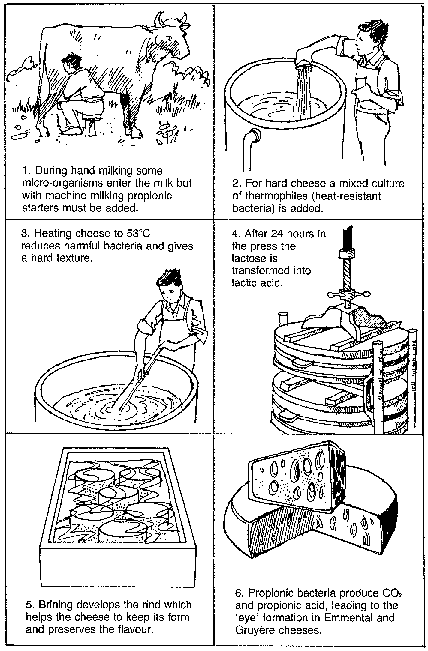Bacteria are microscopic one-cell organisms. Each cell is surrounded by a wall which characterizes the shape of the bacterium. Bacterial shape is an important aid to classification which may be done under the microscope. The cell may be spherical (coccus) or rod-shaped (bacillus) and of varying lengths and diameter.
Bacteria multiply by the simple method of binary division: each cell grows to a critical size and then divides to produce two cells with identical properties. Each cell will subsequently grow and divide at about the same rate as the parent cell. This chain of events will continue until limited by the exhaustion of required nutrients or by accumulation of toxic substances.
Bacteria may be found everywhere on land, in the air, in water, and most bacteria are non-pathogenic. Bacteria are therefore commonly found on the surface of, or in, various food products, such as milk. Even if the milk is obtained under reasonably hygienic conditions and from healthy cows, it always contains some bacteria which, under certain conditions, can multiply within a few hours so that the milk can become unfit for either cheesemaking or drinking. Adequate milk pasteurization (or other heat treatments) will ensure adequate destruction of known pathogens without destroying or affecting to any significant extent the valuable components of milk. The surviving heat-resistant organisms are not of any danger. Pasteurized milk can however be contaminated with all types of micro-organisms.
However, some bacteria such as streptococcus lactis, when growing in milk, convert the mill; sugar (lactose) into lactic acid, an essential ingredient in traditional cheesemaking. Other types of bacteria found in milk and cheese include monococcus, diplococcus, tetracoccus, streptococcus, staphilococcus, lactobacillus and bacterial propionicas.
Factors affecting the survival of bacteria[edit | edit source]
Temperature[edit | edit source]
For each kind of bacteria there is an ideal temperature for maximum growth and reproduction. Some prefer a relatively cool environment(between 5 C and 15 C) while others will grow at temperatures of up to 55 C. Lactic acid-producing bacteria commonly multiply best in temperatures similar to the animal's body temperature. For this reason, untreated milk in churns and tanks that are left or transported in the heat can arrive at the cheese plant with high levels of lactic acid and low levels of lactose. In the production of hard cheese bacteria which can withstand high temperatures (thermophiles) are added. These include Streptococcus thermophilus, Lactobacillus helveticus and propionibacteria.
Each kind of bacteria also has a minimum and maximum temperature within which it can live and multiply, and below or above which it cannot grow. Between 5 C and 10 C, lactic acid-producing bacteria slow down their reproduction rate considerably and so reduce the conversion rate of lactose into lactic acid. Propionic bacteria develop at temperatures over 18 C when they consume lactic acid, producing CO2 and propionic acid, leading to the sweetish flavour and 'eye' formation in Emmental and Gruyere cheeses. When the eyes are well developed the fermentation can be stopped by lowering the store room temperature. Milk stored below 5 does not sour quickly and therefore keeps much longer than warm milk; below 0 C bacteria remain dormant, although they do not die. In addition to specific temperatures for pasteurization, temperature control at each stage of the cheesemaking process is vital (see Table).
Temperature control in cheesemaking.[edit | edit source]
|
Milking |
37.5 |
|
Cooling |
below 15 |
|
Transport to factory |
18 |
|
Reception at factory |
20 |
|
Pasteurization (30 minutes) |
65 |
|
Acidification and coagulation |
33 |
|
Preparation of culture |
22 |
|
Stirring |
35 to 38 |
|
Moulding |
20 |
|
Brine and maturing (neutralization of acid) |
12 to 14 |
Acidity[edit | edit source]
As with temperature, each kind of bacteria prefers a certain level of acidity. Microbes which cause putrifaction and destroy food cannot survive an acid environment. So if cheese and butter contain enough lactic acid produced by bacterial fermentation (Streptococcus lactis for example), they will last for longer. However, when acid levels get too high the bacteria are inhibited; also, too acid a taste will not please the consumer.
Disinfectant[edit | edit source]
A cheese factory should be cleaned first then disinfected with hot water or a chlorine-based substance. All milk churns, tanks, and cheesemaking equipment must be washed, disinfected and rinsed with clean water, preferably tap or running water, and strict hygiene must be observed at all times (see box).
The importance of hygiene[edit | edit source]
- Hygienic milking practices
- Do not use cloth filters to strain the milk
- Do not dilute milk with water
- Do not mix old and new milk
- Cleanliness in the cheese factory
- High quality cultures
- Cleanliness of the separation and moulding equipment
- Daily cleaning of whey tank
- Keep pigs away from dairy
Antibiotics and other inhibitary substances[edit | edit source]
Antibiotics are medicines which kill certain micro-organisms and are used to cure both man and animals of infectious diseases. The lactic bacteria, which produce lactic acid in milk, yoghurt, cultures, and cheeses, are very sensitive to antibiotics such as penicillin. For this reason, milk from cows which were treated with penicillin is not suitable for cheesemaking, since the antibiotics do not permit the growth of bacteria which is important for the fermentation in the cheese. The absence of lactic acid allows the coliforms to increase and produce gases which cause swelling of the cheese. Such milk containing antibiotics must not be used, since even a small quantity can ruin the processing of all of the cheese and butter, in fact it is advisable not to use this milk in any foods destined for human consumption.
Bacteriophage[edit | edit source]
During the author's twenty years of activity in rural cheese factories, problems caused by bacteriophages have never been detected.
Bacteriophages are viruses that are pathogenic to bacteria, affecting above all the streptococcus of lactic cultures. The multiplication of bacteriophage can be so great that they can destroy the acidifying culture overnight.
Figure 4. Propionic acid fermentation of 'Swiss' cheese
It seems that the bacteriophage may only be present in factories using sophisticated processing methods. Therefore, those in charge of rural cheese factories should not waste time trying to hunt down the bacteriophage, since there are many other less complex causes of fluctuations in the acidification of lactic cultures, milk and cheese.
Bacteria in cheese[edit | edit source]
Cheeses do not normally carry disease-producing organisms because its level of acidity, lack of oxygen and low moisture content, combined with bacteriocidal agents such as salt, all combine to prevent the survival and reproduction of pathogens. However, if the cheese has been poorly made and has a low level of lactic acid, or if it is marketed too soon, some harmful organisms may survive. In the USA, many states have laws that if cheese is made from unpasteurized milk it should be held in a cheese store for more than 60 days, at a temperature not lower than 8 C.

